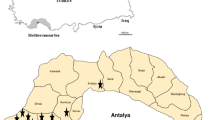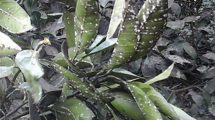Abstract
Seventeen strains of Phialophora verrucosa and one strain of Fonsecaea pedrosoi were isolated from natural sources such as rotting wood, pine bark, pine logs or soil in Japan. These saprophytic isolates were compared morphologically, biologically and serologically with human isolates and their virulence for rats was studied. There were no distinct differences between the isolates from the two sources.
Similar content being viewed by others
References
Benham, R. W., 1931. Certain monilias parasitic on man; their identification by morphology and by agglutination. J. Infect. Dis. 49: 183–215.
Cain, R. F., 1952. Studies of fungi imperfecti. I. Phialophora. Can. J. Bot. 30: 338–343.
Cole, G. T. & Kendrick, B., 1973. Taxonomic studies of Phialophora. Mycologia 65: 661–688.
Conant, N. F., 1937. The occurrence of a human pathogenic fungus as a saprophyte in nature. Mycologia 29: 597–598.
Conti-Díaz, I. A., Mackinnon, J. E. & Civila, E., 1978. Isolation and identification of black yeasts from the external environment in Uruguay. Pan American Health Organization Proceedings of the Fourth International Conference on the Mycoses. Washington, D.C. PAHO Sci. Pub. No. 356, pp. 109–114.
Dixon, D. M., Shadomy, H. J. & Shadomy, S., 1980. Dematiaceous fungal pathogens isolated from nature. Mycopathologia 70: 153–161.
Emmons, C. W., 1954. The significance of saprophytism in the epidemiology of the mycoses. Trans. N. Y. Acad. Sci. 17: 157–166.
Fukushiro, R., 1977. Some considerations on infections by dematiaceous fungi; with special regard to chromomycosis. Jpn. J. Med. Mycol. 18: 398–421.
Gezuele, E., Mackinnon, J. E. & Conti-Díaz, I. A., 1972. The frequent isolation of Phialophora verrucosa and Phialophora pedrosoi from natural sources. Sabouraudia 10: 266–273.
Hughes, S. J., 1958. Revisiones hyphomycetum aliquot cum appendice de nominibus rejiciendis. Can. J. Bot. 36: 727–836.
Klite, P. D., Kelly Jr., H. B. & Diercks, F. H., 1965. A new soil sampling technique for pathogenic fungi. Amer. J. Epidemiol. 31: 124–130.
Komatsu, M., 1969. Notes on the hyphomycetous fungi isolated from sawdust-ricebran media of Pholiota nameko. Rept. Tottori Mycol. Inst. (Japan) 7: 78–89.
Martin, D. W., 1938. The antigenic similarity of a fungus Cadophora americana isolated from wood pulp to Phialophora verrucosa isolated from patients with dermatitis verrucosa (chromoblastomycosis). Amer. J. Trop. Med. 18: 421–426.
Melin, E. & Nannfeldt, J. A., 1934. Researches into the blueing of ground wood-pulp. Svenska Skogsvårdsfören. Tidskr. 32: 397–585.
Montero-Gei, F., 1970. Ecology and epidemiology of chromomycosis. In Proc. Intern. Symp. Mycoses, Paho, pp. 182–184.
Nishimura, K., Miyaji, M. & Kawai, R., 1980. An isolate of Phialophora dermatitidis isolated from a humidifier. Jpn. J. Med. Mycol. 21: 30.
Reis, N. R. & Mok, W. Y., 1979. Wangiella dermatitidis isolated from bats in Manaus Brazil. 17: 213–218.
Ridley, M. F., 1957. The natural habitat of Cladosporium carrionii, a case of chromoblastomycosis in man. Aust. J. Dermatol. 4: 23–27.
Salfelder, K., Schwarz, J., Romero, A., de Liscano, T. R., Zambrano, Z. & Diaz, I., 1968. Habitat de Nocardia asteroides, Phialophora pedrosoi y Cryptococcus neoformans en Venezuela. Mycopathol. et Mycol. Appl. 34: 144–154.
Salonen, A. & Ruokola, A. L., 1969. Mycoflora of the Finnish ‘sauna’. Mycopathol. et Mycol. Appl. 38: 327–336.
Schol-Schwarz, M. B., 1970. Revision of the genus Phialophora (Moniliales). Persoonia 6: 59–94.
Smith, C. D. & Furcolow, M. L., 1964. Efficiency of three techniques for isolating Histoplasma capsulatum from soil including a new flotation technique. J. Lab. Clin. Med. 64: 342–348.
Udagawa, S. & Horie, Y., 1971. Taxonomical notes on mycogenous fungi. I. J. Gen. Appl. Microbiol. 17: 141–159.
Wang, C. J. K., 1965. Fungi of pulp and paper in New York. State Univ. Coll. Forestry Tech. Pub. No. 87, p. 76.
Zweibel, S. M. & Wang, C. J. K., 1978. Reexamination of Phialophora verrucosa. Pan American Health Organization Proceedings of the Fourth International Conference on the Mycoses. Washington D.C. PAHO Sci. Pub. No. 356, pp. 91–100.
Author information
Authors and Affiliations
Rights and permissions
About this article
Cite this article
Iwatsu, T., Miyaji, M. & Okamoto, S. Isolation of Phialophora verrucosa and Fonsecaea pedrosoi from nature in Japan. Mycopathologia 75, 149–158 (1981). https://doi.org/10.1007/BF00482809
Issue Date:
DOI: https://doi.org/10.1007/BF00482809




